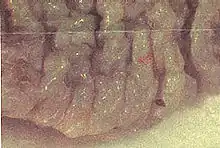John Taylor (pathologist)
John Rippon Taylor (July 26, 1932 – October 27, 2010) was a British-Canadian pathologist and medical researcher. During his academic career, Taylor served as the Associate Professor of Pathology at the University of Manitoba.[1] He is best known for discovering and naming the ridged band of the human prepuce.[1][2][3][4][5][6][7]
John Taylor | |
|---|---|
| Born | July 26, 1932 |
| Died | October 27, 2010 (aged 78) |
| Years active | 1963-1996 |
Notable work | The Prepuce: Specialized Mucosa Of The Penis And Its Loss To Circumcision |
| Title | Pathologist |
| Children | 3 |
Early life and education
Born in the British city of Bradford, Yorkshire: Taylor attended University of Birmingham Medical School. He was accepted to Royal College of Physicians of Edinburgh in 1962 and immigrated to Canada in 1969. He married Margaret Taylor.[1]
Career

Associate Professor of Pathology
Taylor served as the Associate Professor of Pathology at the University of Manitoba.[1]
Retirement
Taylor died in October 2010. He and his wife had three daughters: Alison, Jenny, and Sara.[1] His work is credited with popularizing scientific research into the human foreskin.[1][3][5][6] His work later inspired pathologists Kenneth McGrath[10] and Valeria Purpura.[11]
References
- Cuaj (February 2011). "In Memoriam". Canadian Urological Association Journal. 5 (1): 68. doi:10.5489/cuaj.11024. ISSN 1911-6470. PMC 3036762. PMID 21470519.
Born in Bradford, Yorkshire, England, Dr. Taylor qualified in medicine at the University of Birmingham Medical School, England followed by junior hospital positions in Birmingham, Sheffield and Liverpool, culminating in his acceptance as a member of the Royal College of Physicians of Edinburgh in 1962 and his decision to specialize in Pathology. In 1969 the Taylor family immigrated to Canada. He spent 27 years at the Health Sciences Centre as a forensic pathologist, teacher and researcher and was an Associate Professor of Pathology at the University of Manitoba. He was a doctor and pathologist who after several years of research published a groundbreaking article in the British Journal of Urology in 1996 about the foreskin and what is lost when a male is circumcised. The research led to changes in routine circumcisions in both Canada and the United States.
- Baky Fahmy, Mohamed (2020). Normal and Abnormal Prepuce. Springer International Publishing. p. 44. ISBN 9783030376215.
- Kennedy, Amanda; Milrod, Christine; Kimmel, Michael (2014). Cultural Encyclopedia of the Penis. Rowman & Littlefield Publishers. pp. 73–75. ISBN 9780759123144.
- Glick, Leonard (2005). Marked in Your Flesh: Circumcision from Ancient Judea to Modern America. Oxford University Press. p. 214. ISBN 9780198039259.
- Staff, Ars (February 24, 2015). "The Troubled History of the Foreskin". Ars Technica. Retrieved November 16, 2020.
- Milne, Celia (December 5, 2000). "The Circumcision Debate". The Globe And Mail. Retrieved November 16, 2020.
- Gallo, Luigi (2017-04-07). "The prevalence of an excessive prepuce and the effects of distal circumcision on premature ejaculation". Arab Journal of Urology. 15 (2): 140–147. doi:10.1016/j.aju.2017.02.002. ISSN 2090-598X. PMC 5653616. PMID 29071143.
- Earp, Brian; Sardi, Lauren M.; Jellison, William A. (2017-12-06). "False beliefs predict increased circumcision satisfaction in a sample of US American men". Culture, Health & Sexuality. 20 (8): 945–959. doi:10.1080/13691058.2017.1400104. ISSN 1369-1058. PMID 29210334. S2CID 31826643.
- Sorrells, Morris L.; Snyder, James L.; Reiss, Mark D.; Eden, Christopher; Milos, Marilyn F.; Wilcox, Norma; Howe, Robert S. Van (2007). "Fine-touch pressure thresholds in the adult penis". BJU International. 99 (4): 864–869. doi:10.1111/j.1464-410X.2006.06685.x. ISSN 1464-410X. PMID 17378847. S2CID 24584511.
- McGrath, Ken (2001), "The Frenular Delta", Understanding Circumcision, Boston, MA: Springer US, pp. 199–206, doi:10.1007/978-1-4757-3351-8_11, ISBN 978-1-4419-3375-1, retrieved 2020-11-23
- Purpura, Valeria; Bondioli, Elena; Cunningham, Eric J; De Luca, Giovanni; Capirossi, Daniela; Nigrisoli, Evandro; Drozd, Tyler; Serody, Matthew; Aiello, Vincenzo; Melandri, Davide (December 22, 2018). "The development of a decellularized extracellular matrix–based biomaterial scaffold derived from human foreskin for the purpose of foreskin reconstruction in circumcised males". Journal of Tissue Engineering. 9. doi:10.1177/2041731418812613. ISSN 2041-7314. PMC 6304708. PMID 30622692.